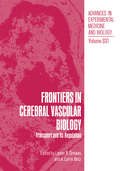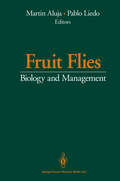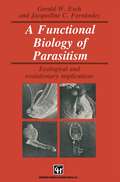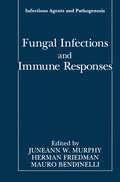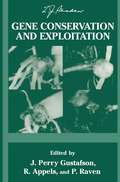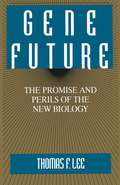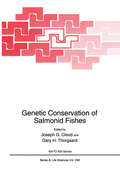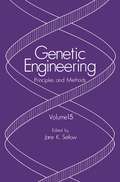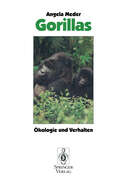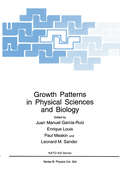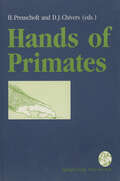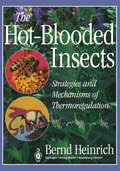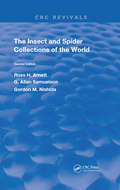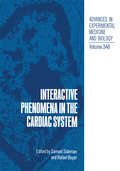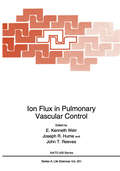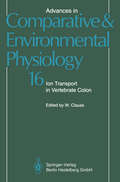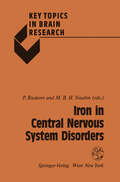- Table View
- List View
Frontiers in Cerebral Vascular Biology: Transport and Its Regulation (Advances in Experimental Medicine and Biology #331)
by Lester R. Drewes A. Lorris BetzDuring the past three decades, the cerebral vasculature and its role in blood-brain transport has been an increasingly active area of investigation and learning, particularly from an anatomical and physiological point of view. However, much less is known at the molecular and cellular level about the blood-brain barrier especially regarding the macromolecules responsible for transport, the roles played by vascular wall components (endothelial cell, pericyte, smooth muscle, basement membrane), and the mechanisms regulating brain vascular-specific protein expression and their molecular alterations during development and disease. Fundamental questions still unanswered include: What are the molecular constituents of brain endothelial cell tight junctions? What are the membrane proteins responsible for transport of specific substrates? What are the molecular signals that cause glucose transporter gene expression to be 20 to 100 times greater in brain endothelial cells in vivo than in vitro? What roles do pericytes, smooth muscle cells and basement membrane have in establishing or maintaining blood-brain transport characteristics? Are brain vascular transport systems responsible for edema following injury? Are transporter systems regulated via receptor-mediated events? Do hormones or neuromodulators regulate transporter expression? What is the molecular mechanism by which plasma proteins enter the extravascular space? Are transporters asymmetrically distributed between the luminal and abluminal endothelial cell membranes? Can prodrugs or pharmacologic agents be designed as substrate analogs and be delivered to the central nervous system via existing transporters or receptors? Can new and beneficial transporters be introduced into the brain vasculature?
Fruit Flies: Biology and Management
by Martin Aluja Pablo LiedoFruit flies are enormously important economic pests, as California has learned over the past few years (remember the Mediterranean Fruit Fly?). The problem is expected to get worse, and issues of both basic research and control measures are very important for this pest. This book is the edited, camera-ready proceedings of a recent international symposium on fruit flies of economic importance. It covers current knowledge of fruit fly physiology, genetics, morphology and behavior. It discusses action programs for controlling and using fruit flies in agronomy, as well as the problem of fruit flies in the fruit growing industry.
A Functional Biology of Parasitism: Ecological and evolutionary implications (Topics in Gastroenterology)
by Jacqueline C. Fernández Gerald W. EschSeries Editor: Peter Calow, Department of Zoology, University of Sheffield, England The main aim of this series will be to illustrate and to explain the way organisms 'make a living' in nature. At the heart of this - their functional biology - is the way organisms acquire and then make use of resources in metabolism, movement, growth, reproduction, and so on. These processes will form the fundamental framework of all the books in the series. Each book will concentrate on a particular taxon (species, family, class or even phylum) and will bring together information on the form, physiology, ecology and evolutionary biology of the group. The aim will be not only to describe how organisms work, but also to consider why they have come to work in that way. By concentration on taxa which are well known, it is hoped that the series will not only illustrate the success of selection, but also show the constraints imposed upon it by the physiological, morphological and developmental limitations of the groups. Another important feature of the series will be its organismic orientation. Each book will emphasize the importance of functional integration in the day to-day lives and the evolution of organisms. This is crucial since, though it may be true that organisms can be considered as collections of gene determined traits, they nevertheless interact with their environment as integrated wholes and it is in this context that individual traits have been subjected to natural selection and have evolved.
Fungal Infections and Immune Responses (Infectious Agents and Pathogenesis)
by Juneann W. Murphy Herman Friedman Mauro BendinelliBiomedical scientists widely acknowledge that individuals' immune respon siveness is important in resistance to infections by microorganisms, including fungi. Because of the devastating acquired immunodeficiency syndrome (AIDS) epidemic, caused by the human immunodeficiency retrovirus, it is now accepted that suppressed immune responses, especially cellular immu nity, are important contributors to increased individual susceptibility to opportunistic infections-including infections caused by fungi which were at one time thought to be very lowly or nonpathogenic. Within the last few years, there has been an almost explosive increase in interest and studies concerning the nature and mechanisms of the immune response to fungal infections. Many immunologists who are not well versed in mycology have begun to study the nature and mechanisms of antifungal immunity using a wide variety of newer as well as more conventional immunologic technologies, both in vivo and in vitro. Up to the 1980s, however, there was little interest among basic immunologists concerning fungal immunity. This situation has changed dramatically in the past half decade, mainly because of AIDS.
Gene Conservation and Exploitation: 20th Stadler Genetics Symposium (Stadler Genetics Symposia Series)
by J. Perry Gustafson Rudi Appels P. RavenThe potato (Solanum tuberosum L. ) tuber is a major food source in many countries of the world, and subsequently potato has been the target of a good deal of effort directed at engineering disease and herbicide tolerance, and improvements in various crop characteristics. Consequently investigations into the regulation of gene expression in tubers is relevant to these endeavours, as tubers are the main target organ for modification of gene expression. We have been interested in the regulation of genes in tubers for these reasons. Morphologically tubers are modified stems, which have enlarged radially by limited cell division and substantial expansion. At the molecular level, tuber development is characterised by a massive increase in starch deposition and the synthesis of a limited number of abundant proteins. These include proteinase inhibitors and a 40kd group of proteins called patatin, which are acyl hydrolases. Together these proteins account for over 50% of tuber proteins (reviewed by Bevan, 1991). The synthesis of these proteins has parallels to the synthesis of other somatic storage proteins, especially the VSP proteins of soybean. In both potato and soybean, removal of the sink for these proteins (tubers and pods, respectively) causes deposition in other tissues (Staswick, 1990). It is hypothesised that transcriptional control of the genes encoding these proteins is regulated in part by source-sink relationships of metabolites or other factors. In the case of VSPs, both amino acid levels and jasmonic acid play a major regulatory role (Staswick et aI.
Gene Future: The Promise and Perils of the New Biology
by Thomas F. LeeWe are poised at the doorway to a future which could surpass the Industrial Revolution in its impact on the world. We are beginning to scrutinize genes in order to read the very history of evolution, and to alter plants and animals in ways undreamed of only a few years ago. As the tools of science have become more sophisticated, scientists have been able to delve deeply into the inner recesses of cells. The fruit of their labor, the new biology, promises us an unprecedented understanding of genes, offering an illuminating view into the most intimate operations of living things from microbes to humans - and with that, the potential to gain increasing control over life itself. Our gene future will soon present us with a cornucopia of products by drawing upon a variety of organisms - plants, animals, and even human cells - that will influence the lives and health of us all. As Thomas Lee, a biologist and author of the acclaimed The Human Genome Project: Cracking the Genetic Code of Life, so vividly shows, the new biology is already beginning to make its mark on our lives. Every week newspapers announce that scientists have found the gene for a disease such as cystic fibrosis or a particular form of cancer, or have seized on a gene therapy to try to combat it. The controversy over using DNA fingerprinting as admissible evidence in court has sparked public concern. The injecting of experimental genes into humans and animals has triggered recent debates. Soon genetically engineered tomatoes and other "transgenic" vegetables will be available on the shelves of our local grocers. As Lee so wisely and eloquently cautions, there may be perils along this pathway as well as miraculous discoveries. Do dangers lurk in this new technological approach to nature? May we unwittingly be doing irreparable harm to individuals, not to mention the biosphere? This perceptive author even-handedly assesses the controversies surrounding the perils that may await us as molecular science m
Genetic Conservation of Salmonid Fishes (Nato Science Series A: #248)
by Joseph G. Cloud Gary H. ThorgaardAs the human population increases and nations become more industrialized, the habitat and water quality required for the survival of fish continues to decline. In addition to these environmental factors, fish populations are directly or potentially affected by harvesting, enhancement programs and introgression with hatchery-propagated or transgenic fish. To our knowledge no other scientific meeting has been assembled to consider the breadth of the problem, to review the technology that is presently available for the preservation of the germ plasm of salmonid stocks and to identify the scientific advances that are required to overcome the problems. Because many salmonids have spawning grounds within the confines of a specific region or county but will spend a large portion of their life cycle within the territorial waters of other countries or in the open ocean, the preservation of unique genes or gene pools in these animals requires international cooperation. This scientific meeting has provided a forum in which to discuss the problems, evaluate the present methods or technology for addressing the problems and suggest new directions or innovations that need to be implemented. During this meeting we limited our discussion to salmonid fishes. However, the general conclusions about the factors that affect the population dynamics of fish stocks and the technical aspects concerning the preservation of germ plasm will be applicable to other fish species.
Genetic Engineering: Principles and Methods (Genetic Engineering: Principles and Methods #15)
by Jane K. SetlowThe current volume covers human gene therapy, improving the nutritional value of maize, restriction-modification enzymes, and eight other subjects.
Goat Husbandry
by David MackenzieThis is a book every goat-keeper should have. The latest edition has been extensively revised by Ruth Goodwin, a well-known expert, to reflect the changes in the goat-keeping world since publication of the previous edition. She has incorporated her revisions with great skill without losing the character of what is a classic work.
Growth Patterns in Physical Sciences and Biology (Nato Science Series B: #304)
by Juan Manuel Garcia-Ruiz Enrique Louis P. Meakin Leonard M. SanderDuring the past decade interest in the formation of complex disorderly patterns far from equilibrium has grown rapidly. This interest has been stim ulated by the development of new approaches (based primarily on fractal geometry) to the quantitative description of complex structures, increased understanding of non-linear phenomena and the introduction of a variety of models (such as the diffusion-limited aggregation model) that provide paradigms for non-equilibrium growth phenomena. Advances in computer technology have played a crucial role in both the experimental and theoret ical aspects of this enterprise. Substantial progress has been made towards the development of comprehensive understanding of non-equilibrium growth phenomena but most of our current understanding is based on simple com puter models. Pattern formation processes are important in almost all areas of science and technology, and, clearly, pattern growth pervades biology. Very often remarkably similar patterns are found in quite diverse systems. In some case (dielectric breakdown, electrodeposition, fluid-fluid displacement in porous media, dissolution patterns and random dendritic growth for example) the underlying causes of this similarity is quite well understood. In other cases (vascular trees, nerve cells and river networks for example) we do not yet know if a fundamental relationship exists between the mechanisms leading the formation of these structures.
Hands of Primates
by Holger Preuschoft and David J. ChiversThe hand commonly is considered to have exerted great influence on the evolution of typically human characteristics, like upright posture, stereoscopic vision, «manipulative» handling of parts of the environment. The German term «Begreifen», which is commonly used for the understanding of complex relationships in a generalised, abstract sense, always implies the original meaning of seizing objects with the aid of the hands. The hands are also of greatest importance for the survival of the other, non-human primates. Hands are absolutely essential for locomotion in an arboreal habitat, and the intake of food is dependant on the use of the hands as well: primates very rarely take in food directly with their mouths, in the wast majority of cases they seize food items with their hands. Even drinking is often performed by dipping the hand into the water and licking the drops from hand and forearm. An organ of such importance will very probably be «adapted» to its «function». This statement is made so often, that any further considerations seem superfluous. Nobody doubts, that the hands of primates are highly adaptive organs, the general form and internal structure of which are closely related to the necessities of life. However, if one tries to go beyond this general statement, he finds himself confront ed with several problems: First of all, a point which W. GUTMANN has emphasized repeatedly: according to the results obtained by genetics, the first thing to appear is the mutated character.
Hedgehogs Don't Eat Hamburgers
by Vivian French Chris FisherHector and Hattie and Harry and Hester set off to find a nice juicy hamburger. But Fox doesn’t want a hamburger, and neither does Badger. What they want are four nice fat juicy hedgehogs for their tea! Two funny stories about four friendly hedgehogs, perfect for beginner readers.
The Hot-Blooded Insects: Strategies and Mechanisms of Thermoregulation
by Bernd Heinrich"From one man's persistent and elegant probing of the temperature biology of bees, we have been led to a deeper understanding of the whole biology of many insect taxa, and of their interactions with ecological and environmental stresses: all who work at the interfaces of physiology, ecology and behaviour have cause to be grateful, and all should certainly read this book." (Trends in Ecology & Evolution) "An outstanding source of information, and can be read with profit and satisfaction by the professional biologist and interested amateur alike." (Nature)
Human Body Composition: In Vivo Methods, Models, and Assessment (Basic Life Sciences #60)
by Kenneth J. Ellis Jerry D. EastmanThis book is the compilation of papers presented at the International Symposium on In Vivo Body Composition Studies, held in Houston, Texas, November 10-12, 1992. The purpose of this conference was to report on the state-of-the-art techniques for in vivo body composition measurements and to present the most recent human data on normal body composition and changes during disease. This conference was the third in a series of meetings on body composition studies held in North America, and follows the successful meetings at Brookhaven National Laboratory in 1986, and the one in Toronto in 1989. A large number of excellent research papers were offered for consideration at this Conference which demonstrates the rapid growth of the field in the last three years. However, we had to limit the presentations to approximately 90 papers which provided a broad spectrum of the applications and recent interest in the subject. The proceedings of the Brookhaven meeting "In Vivo Body Composition Studies", is published by The Institute of Physical Sciences in Medicine, London. The proceedings of the Toronto meeting "In Vivo Body Composition Studies" was published by Plenum Press in its basic life science series. Both these meetings placed more emphasis on technical aspects while the current Houston meeting tried to emphasize more the emerging clinical applications of these techniques. The general sessions used at the Conference for presentations forms the basis of the order of appearance of the papers in this book.
The Inadequate Environment: Nitrogen and the Abundance of Animals
by Thomas C.R. WhiteEcology is characterized by a rapidly growing complexity and diversity of facts, aspects, examples, and observations. What is badly needed is the development of common patterns, of rules that, as in other sciences such as physics, can more generally explain the increasing complexity and variability we observe. Tom White, being one of the "seniors" in ecology, makes such an attempt in his book. the pattern he shows and explains with numerous examples from the entire animal kingdom is a universal hunger for nitrogen, a misery that drives the ecology of all organisms. He advocates that the awareness of this fundamental role that the limitation of nitrogen plays in the ecology of all organisms should be as a much part of each ecologis's intellectual equipment as is the awareness of the fact of evolution by means of natural selection. His claim is that not "enery" but "nitrogen" is the most limited "currency" in the animal world for the production and growth of their young.
Insect Immunity (Series Entomologica #48)
by J. P. N. PathakImmunity in insects is different from immunity in vertebrates. Insects lack immunoglobulins even though they are capable of reacting against foreign components with effective defense mechanism. There has been a marked advancement in most of the fields of science in the past two decades. Insect immunity is also one of them. It is a developing subject which is now established as a new branch in insect study. This treatise is an attempt to compile meaningful articles of leading workers in this field, nevertheless we do not claim that leadership in insect immunity is by any means restricted to them. The idea is to provide a vibrant description of various aspects of "Insect Immunity". With the rapid development of the subject, it is difficult for any one author to discuss all the aspects of an area in a limited number of pages, even then they have done their utmost to include the entire development of the subject in their articles. The treatise deals with insect haemocytes, their population, isolation and role in defense mechanism, humoral encapsulation, inducible humoral antibacterial immunity, cellular immune reactions, role of endocrines, role of prophenol oxidase system in cellular communication, haemagglutinins and impact of parasite on insect immune system. Some topics could not be covered because experts in those area though willing could not complete their commitment within time limits.
Insect Learning: Ecology and Evolutinary Perspectives
by Daniel R. Papaj Alcinda C. LewisInsect Learning is a comprehensive review of a new field. Until recently, insects were viewed as rigidly programmed automatons; now, however, it is recognized that they can learn and that their behavior is plastic. This fundamental change in viewpoint is causing a re-examination of all aspects of the relationship between insects and their environment. This change in perspective is occurring at a time of heightened interest in brain function in both vertebrates and invertebrates. Insects potentially play a major role in this expanding area. Because of their experimental tractability and genetic diversity, they provide unique opportunities for testing hypotheses on the ecology and evolution of learning. As organisms of economic importance, they are perennial objects of research by both basic and applied scientists. Insect Learning covers both social and non-social insects from multiple perspectives. The book covers mechanisms; syntheses of work on physiology, behavior, and ecology; and micro- and macroevolution. The concluding section discusses future directions for research, including applications to pest management.
The Insect & Spider Collections of the World (CRC Press Revivals)
by Ross H. Arnett, Jr. G. Allan Samuelson Gordon M. NishidaFirst published in 1993, completely rewritten, this second edition includes a list of all 210 countries of the world and all of the islands, with comments on the existence of insect and spider collections, both public and private. These listings are arranged alphabetically by country, state/province, and city, with private collections listed under the public collection with which they are registered. Part II of the directory is an alphabetical list of the codes assigned to each of the collections described in Part I. This list is also cross-referenced to variations of the codes used in other works, which will eliminate any confusion over this duplication. This classic work provides a ready reference to all collections and is required by all insect and spider systematists.
The Insect & Spider Collections of the World (CRC Press Revivals)
by Ross H. Arnett, Jr. G. Allan Samuelson Gordon M. NishidaFirst published in 1993, completely rewritten, this second edition includes a list of all 210 countries of the world and all of the islands, with comments on the existence of insect and spider collections, both public and private. These listings are arranged alphabetically by country, state/province, and city, with private collections listed under the public collection with which they are registered. Part II of the directory is an alphabetical list of the codes assigned to each of the collections described in Part I. This list is also cross-referenced to variations of the codes used in other works, which will eliminate any confusion over this duplication. This classic work provides a ready reference to all collections and is required by all insect and spider systematists.
Interactive Phenomena in the Cardiac System (Advances in Experimental Medicine and Biology #346)
by S. Sideman Rafael BeyerThe cardiac system represents one of the most exciting challenges to human ingenuity. Critical to our survival, it consists of a tantalizing array of interacting phenomena, from ionic transport, membrane channels and receptors through cellular metabolism, energy production to fiber mechanics, microcirculation, electrical activation to the global, clinically observed, function, which is measured by pressure, volume, coronary flow, heart rate, shape changes and responds to imposed loads and pharmaceutical challenges. It is a complex interdisciplinary system requiring the joint efforts of the life sciences, the exact sciences, engineering and technology to understand and control the pathologies involved. The Henry Goldberg Workshops were set up to address these multivariable, multidisciplinary challenges. Briefly, our goals are: To encourage international cooperation and foster interdisciplinary interaction between scientists from the different areas of cardiology; to relate microscale cellular phenomena to the global, clinically manifested cardiac function; to relate conceptual modeling and quantitative analysis to experimental and clinical data; to gain an integrated view of the various interacting parameters, identify missing links, catalyze new questions, and lead to better understanding of the cardiac system. The outstanding success of past workshops has encouraged their continuation. The first Henry Goldberg Workshop, held in Haifa in 1984, introduced the concept of interaction between mechanics, electrical activation, perfusion and metabolism, emphasizing imaging in the clinical environment. The second Workshop, in 1985, discussed the same parameters with a slant towards the control aspects.
Ion Flux in Pulmonary Vascular Control (Nato Science Series A: #251)
by E. Kenneth Weir Joseph R. Hume John T. Reeves6 Ions can pass through a single membrane channel at a rate of 10 ions/second. Over the last decade the ability to measure ion flux so precisely and to document the opening and closing of individual ion channels has provided a powerful tool to those working on smooth muscle physiology and vascular reactivity. The use of potassium channel blockers by Tom Lloyd in the 1960s and calcium channel blockers by Ivan McMurtry in the 1970s indicated the importance of ion flux in regulating pulmonary vascular tone. Recent advances in technology. principally the patch-clamp technique and fluorescent ion-sensitive dyes. now permit a more detailed description of physiologic mechanisms. This volume arises from the Sixth Grover Conference on the Pulmonary Circulation. a NATO Advanced Research Workshop. held in Colorado in October 1992. A group of international sCientists who are leaders in the field of ion flux focused their attention on the problems of the pulmonary vasculature. The chapters in this book describe the present state of knowledge of the movement and storage of ions in vascular endothelial and smooth muscle cells. Those who are not familiar with the techniques of patch clamping and calcium imaging will find an introduction to these methods in the chapters by Leblanc and Wan and Archer et al. The role of potassium channels in oxygen sensing illustrates the rapid progress which the study of ion currents has made possible.
Ion Transport in Vertebrate Colon (Advances in Comparative and Environmental Physiology #16)
by W. Clauss M. Avella K. E. Barrett H. J. Binder D. C. Dawson W. V. Engelhardt R. Greger J. P. Hayslett R. Krattenmacher K. Kunzelmann B. Lahlou M. A. Post V. M. Rajendran G. Rechkemmer G. I. Sandle E. Skadhauge M. TilmanStudies on the colon not only serve medical interest or clinical purposes, but are also a highly interesting subject of comparative physiology, from which we can learn much about the basic principles in physiology. Presented here are examples of research on colonic ion transport of each vertebrate group, including the classical models of epithelia, rat and rabbit, and also on the special and unique features in fish, amphibians, reptiles, birds, and selected mammals such as the guinea pig. Physiology and pathophysiology of ion transport in the human large intestine are as well covered as the use of colonic cell cultures as model systems for crypt cell properties.
Iron in Central Nervous System Disorders (Key Topics in Brain Research)
by M. B. H.Youdim PeterRiedererThe role of the metals copper, zinc, magnesium, lead, manganese, mercury, lithium and aluminium in neuropsychiatric disease are well known and has been discussed on several occasions. Yet little attention has been paid to iron, the most abundant transitional metal in the body and the earth's crust. Iron plays a major role as a cofactor of numerous metabolic enzymes, it is important for DNA and protein synthesis, and has a crucial role in the oxygen carrying capacity of haemoglobin. Some of the most devastating diseases of systemic organs are associated with abnormal iron metabolism. Yet only very recently its role in the central nervous system has been considered. Thus nutritional iron defi ciency and iron overload afflict some 500-600 million people. It is also well recognized that too little or too much iron can produce profound effects on the metabolic state of the cell, and therefore the regulation of iron uptake and disposition is tightly relegated by the cell. Its transport into the cell and storage are handled by transferrin, ferritin and haemo siderin. Nowhere are these processes so well recognized as in the case of brain iron metabolism. Iron does not have ready access to the adult brain as it does to other tissues, since it does not cross the blood brain barrier (BBB). All the iron present in brain is deposited before the closure of BBB at an early age where it is sequestered and conserved. Therefore its turnover is extremely slow.
